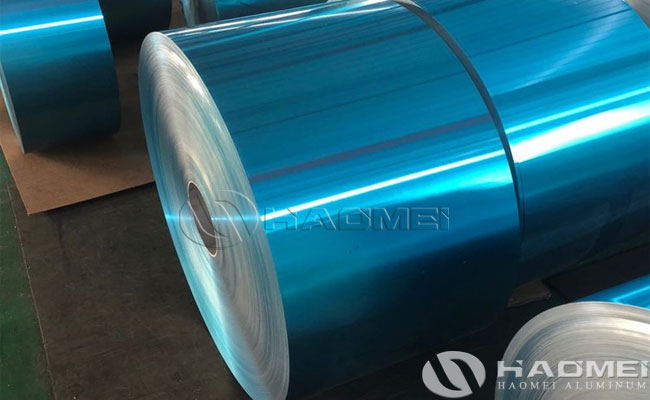Hydrophilic aluminum fin stock are core functional materials in the refrigeration and heat exchange industry. By applying a multi-layer functional coating to an aluminum alloy substrate, they address the condensation, corrosion, and low heat exchange efficiency issues of traditional aluminum fins. They are widely used in various heat exchange equipment.

Material System: Collaborative Design of Substrate and Coating
The performance of hydrophilic aluminium fin stock depends on the synergistic effect of the “substrate + multi-layer coating” system. The selection and processing of each component directly determine the final quality.
- Substrate: High-Precision Aluminum Alloy Foil
The substrate must simultaneously meet the three core requirements of lightness, ductility, and thermal conductivity. The following two types of aluminum alloys are the mainstream choices:
– 8011 Aluminum Alloy
Al-Mn (manganese) alloys offer excellent ductility and are easy to stamp and form. They are also cost-effective and suitable for mass production. They are suitable for low- and medium-load applications such as residential air conditioners and small commercial air conditioners.
– 3102 Aluminum Alloy
Al-Mg (magnesium) alloy offers higher strength and deformation resistance. Its thermal conductivity is slightly better than 8011 aluminum foil, making it suitable for long-term, high-load operation in equipment such as central air conditioners and automotive air conditioners.
- Strict standards are imposed on the physical parameters of the substrate:
– Thickness: 0.08-0.20mm (0.10-0.12mm is common for household air conditioners, and 0.15-0.20mm is common for commercial equipment). Thickness tolerance must be controlled within ±0.005mm to ensure uniform fin spacing.
– Width: 300-1100mm, customizable to suit heat exchanger dimensions. No wavy deformation across the width must be achieved (flatness ≤ 0.5mm/m).
– Surface Condition: The substrate surface must be degreased and pickled to remove oil and oxide layers to ensure coating adhesion (adhesion testing must meet Level 1 standards in GB/T 9286).
- Coating System: Precise Matching of Three Functional Films
The coating utilizes a composite structure of “basecoat + hydrophilic coating + topcoat,” with each layer complementing its functions. The total coating thickness is controlled at 3-5μm (too thick will reduce thermal conductivity, while too thin will affect durability).
– Base Coating (Corrosion-Resistant Layer)
Water-soluble epoxy resin, polyester resin, chromate (or chromium-free passivation agent, environmentally friendly)
Enhances adhesion between the substrate and the hydrophilic layer;
Isolates air and moisture to prevent corrosion of the aluminum substrate
Salt spray resistance: No red rust after ≥ 500 hours in a neutral salt spray test;
Alkali resistance: No peeling after immersion in 5% NaOH solution for ≥ 24 hours
– Hydrophilic Coating (Functional Layer)
Carboxyl/hydroxyl-containing acrylic resin, nano-silica (enhances hydrophilic stability), antimicrobial agent (optional)
Reduces water contact angle (≤ 15°, ≤ 10° for high-quality products), allowing condensed water to spread quickly;
Prevents condensed water from beading and clogging fin gaps
Hydrophilic durability: Contact angle change ≤ 5° after immersion in 100°C hot water for 100 hours;
Antibacterial Properties: ≥99% inhibition rate against Escherichia coli and Staphylococcus aureus (models with antibacterial function)
– Top Coating (Protective Layer)
Polyolefin Resin, Fluorocarbon Resin (High-End Models)
Improves coating wear resistance (no scratches after ≥500 abrasion tests);
Prevents dust adhesion, reducing cleaning frequency
Temperature Resistance: Long-term use in temperatures from -30°C to 120°C without cracking;
Stain Resistance: Surface dust is easily washed away with water, leaving no residue.
Core Performance Indicators and Testing Standards
The performance of hydrophilic aluminum finstock is verified through rigorous laboratory testing. Key indicators and industry standards are as follows:
– Hydrophilicity: Water Contact Angle, Hydrophilic Durability
Initial contact angle ≤10°, ≤15° after 100 hours of immersion in hot water at 100°C.
– Corrosion Resistance: Neutral salt spray, acid and alkali resistance, and humidity and heat resistance
No red rust after ≥500 hours of salt spray, no corrosion after 24 hours of immersion in 5% H₂SO₄
– Heat Exchange Efficiency: Airflow Resistance, Heat Exchange Improvement Rate
Reduces airflow resistance by 15%-20%, increases heat exchange by 8%-12%
– Mechanical Properties: Coating Adhesion and Abrasion Resistance
Adhesion Grade 1, ≥500 abrasions without coating detachment
– Environmental Protection: Heavy Metal Content (Lead, Cadmium, Chromium, etc.)
Heavy metal content ≤1000ppm (RoHS limit), no banned substances
Application Scenarios
The performance requirements for hydrophilic aluminium finstock for heat exchange equipment in different fields vary significantly, necessitating targeted selection:
- Mainstream Applications
– Household air conditioners (wall-mounted units, cabinet units):
8011 base material with a chrome-free coating (environmentally friendly) is preferred. Long-lasting hydrophilicity and reasonable cost are required. Typical thicknesses are 0.10-0.12mm, and widths are customized based on evaporator size (e.g., 700mm, 900mm).
– Central air conditioners (VRFs, chillers):
High corrosion resistance and strength are required. 3102 base material with a fluorocarbon top coating is selected, with a thickness of 0.15-0.20mm. Some models require antibacterial properties (to prevent mold growth in condensate).
– Automotive air conditioners:
High and low temperature resistance (-40°C to 150°C) and vibration resistance are required. 3102 base material with a weather-resistant coating is selected, with a coating thickness of 3-4μm (to avoid compromising thermal conductivity). The coating must also pass oil and antifreeze corrosion tests. – Refrigerator/Freezer: Requires resistance to low temperatures (below -30°C) and high humidity. Choose 8011 base material with a thick undercoat (≥ 2μm) to prevent fin corrosion in low-temperature, high-humidity environments.
Key Selection Factors
- Environmental Adaptability: For high-humidity environments (such as the southern coastal areas), choose a model with a high salt spray resistance; for low-temperature environments, choose a model with a low-temperature coating.
- Equipment Load: For long-term high-load operation (such as central air conditioning), choose 3102 base material; for short-term intermittent operation (such as household air conditioners), choose 8011 base material.
- Environmental Requirements: For exports to Europe and North America, choose RoHS 2.0 and REACH-compliant products, and avoid chromium-containing coatings.
